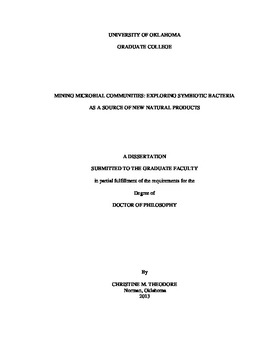| dc.description.abstract | As ubiquitous inhabitants of Earth, bacteria represent a diverse resource in the search for new natural products. In order for the field of natural products to progress, new and exciting sources of biodiversity must be continually accessed. Microbiomes, the community of commensal and pathogenic microorganisms that live in and on other organisms, present a unique opportunity to access new biological diversity. These symbiotic bacteria have proven to be prolific producers of natural products and represent relatively untapped resource of new secondary metabolites.
Photorhabdus asymbiotica, a bacterial symbiont of an entomopathogenic nematode is an emerging health concern for humans. It engages in a bi-phasic lifestyle that switches between symbiotic and pathogenic phases. Its genome had been previously sequenced and our analysis of the secondary metabolite pathways indicated it had the genetic machinery necessary to produce multiple natural products. Extensive media screening studies were employed to induce the production of the encoded for natural products. Two known and one new proteasome inhibitors were isolated from the optimized culture conditions. The theory that P. asymbiotica’s lifestyle switch is governed in part by environmental cues was explored by injecting the bacterium into live crickets. Recovery of the bioactive natural products from the cricket corpus supported the belief that the nutrient composition of the insect gut plays a role in the life cycle switch of P. asymbiotica.
The microbiomes of mammals are a rich and diverse source of bacteria. While these microbiomes are well studied in terms of populations, little is known about their ability to produce natural products. The biosynthetic potential of the microbiome of a feral hog was examined. One isolated organism, identified as a new strain of Brevibacillus latersporus, was chosen for further genomic and metabolomic characterization. Thirty two biosynthetic gene clusters were identified in the organism’s genome. Three known bioactive compounds were isolated along with two new natural products. A portion of the known and new natural products were matched up with their biosynthetic gene clusters. This work showed that symbiotic bacteria from small mammals are worthy of further investigation by natural product investigators.
Finally, a method was developed to sample, isolate, and screen members of microbiome communities for biosynthetically talented and culturable organisms. By employing the use of liquid handling robots and specialized instrumentation, an efficient method for quickly evaluating organisms for secondary metabolites was created. By combining an efficient screening method and metabolomic investigations, a snap shot of the chemical products generated by microbiome members has been achieved. | en_US |
